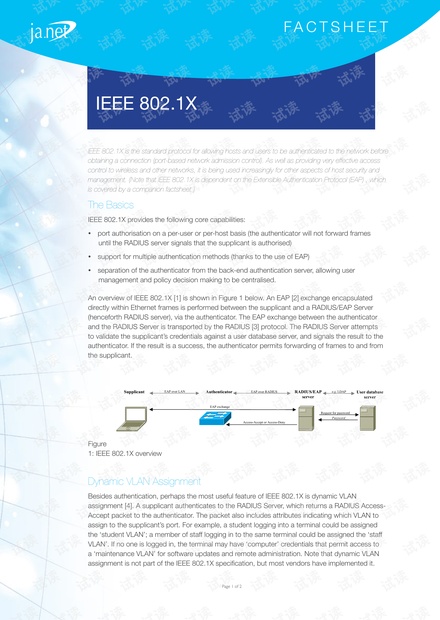没有合适的资源?快使用搜索试试~ 我知道了~
首页IEEE 802.1X
IEEE 802.1X is the standard protocol for allowing hosts and users to be authenticated to the network before obtaining a connection (port-based network admission control). As well as providing very effective access control to wireless and other networks, it is being used increasingly for other aspects of host security and management. (Note that IEEE 802.1X is dependent on the Extensible Authentication Protocol (EAP) , which is covered by a companion factsheet.)
资源详情
资源评论
资源推荐

IEEE 802.1X
IEEE 802.1X is the standard protocol for allowing hosts and users to be authenticated to the network before
obtaining a connection (port-based network admission control). As well as providing very effective access
control to wireless and other networks, it is being used increasingly for other aspects of host security and
management. (Note that IEEE 802.1X is dependent on the Extensible Authentication Protocol (EAP) , which
is covered by a companion factsheet.)
The Basics
IEEE 802.1X provides the following core capabilities:
• port authorisation on a per-user or per-host basis (the authenticator will not forward frames
until the RADIUS server signals that the supplicant is authorised)
• support for multiple authentication methods (thanks to the use of EAP)
• separation of the authenticator from the back-end authentication server, allowing user
management and policy decision making to be centralised.
An overview of IEEE 802.1X [1] is shown in Figure 1 below. An EAP [2]
exchange encapsulated
directly within Ethernet frames is performed between the supplicant and a RADIUS/EAP Server
(henceforth RADIUS server), via the authenticator. The EAP exchange between the authenticator
and the RADIUS Server is transported by the RADIUS [3] protocol. The RADIUS Server attempts
to validate the supplicant’s credentials against a user database server, and signals the result to the
authenticator. If the result is a success, the authenticator permits forwarding of frames to and from
the supplicant.
Figure
1: IEEE 802.1X overview
Dynamic VLAN Assignment
Besides authentication, perhaps the most useful feature of IEEE 802.1X is dynamic VLAN
assignment [4]. A supplicant authenticates to the RADIUS Server, which returns a RADIUS Access-
Accept packet to the authenticator. The packet also includes attributes indicating which VLAN to
assign to the supplicant’s port. For example, a student logging into a terminal could be assigned
the ‘student VLAN’; a member of staff logging in to the same terminal could be assigned the ‘staff
VLAN’. If no one is logged in, the terminal may have ‘computer’ credentials that permit access to
a ‘maintenance VLAN’ for software updates and remote administration. Note that dynamic VLAN
assignment is not part of the IEEE 802.1X specification, but most vendors have implemented it.
Page 1 of 2
FACTSHEET
Supplicant
Authenticator
EAP exchange
EAP over LAN
EAP over RADIUS
RADIUS/EAP
server
Access-Accept or Access-Deny
User database
server
Request for password
Password
e.g. LDAP
brightcolour
- 粉丝: 2
- 资源: 1
上传资源 快速赚钱
 我的内容管理
收起
我的内容管理
收起
 我的资源
快来上传第一个资源
我的资源
快来上传第一个资源
 我的收益 登录查看自己的收益
我的收益 登录查看自己的收益 我的积分
登录查看自己的积分
我的积分
登录查看自己的积分
 我的C币
登录后查看C币余额
我的C币
登录后查看C币余额
 我的收藏
我的收藏  我的下载
我的下载  下载帮助
下载帮助

会员权益专享
最新资源
- zigbee-cluster-library-specification
- JSBSim Reference Manual
- c++校园超市商品信息管理系统课程设计说明书(含源代码) (2).pdf
- 建筑供配电系统相关课件.pptx
- 企业管理规章制度及管理模式.doc
- vb打开摄像头.doc
- 云计算-可信计算中认证协议改进方案.pdf
- [详细完整版]单片机编程4.ppt
- c语言常用算法.pdf
- c++经典程序代码大全.pdf
- 单片机数字时钟资料.doc
- 11项目管理前沿1.0.pptx
- 基于ssm的“魅力”繁峙宣传网站的设计与实现论文.doc
- 智慧交通综合解决方案.pptx
- 建筑防潮设计-PowerPointPresentati.pptx
- SPC统计过程控制程序.pptx
资源上传下载、课程学习等过程中有任何疑问或建议,欢迎提出宝贵意见哦~我们会及时处理!
点击此处反馈



安全验证
文档复制为VIP权益,开通VIP直接复制
 信息提交成功
信息提交成功
评论1